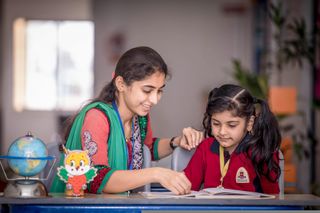The Biden-Harris Administration recently called on schools to implement high-quality tutoring to help students overcome learning disruptions caused by the COVID pandemic.
The administration has urged schools to utilize the $122 billion in funding through the American Rescue Plan to launch high-quality tutoring, summer learning and enrichment, and afterschool programs. The administration has also launched the National Partnership for Student Success (NPSS), which aims to provide students with an additional 250,000 tutors and mentors over the next three years.
Tutoring researchers were pleased by the attention the administration is giving to tutoring but advised school leaders to make sure to implement evidence-based tutoring interventions.
What This Means for Tutoring
Matthew Kraft, an associate professor of Education & Economics at Brown University who has studied tutoring extensively, says the administration’s public support of tutoring is a step in the right direction. “The federal government has a really important role to play in convening all the actors that are involved in this effort, in helping to support research that identifies best practices, and helping to fund these efforts,” he says.
The Biden-Harris Administration announcement noted that, “Research has consistently shown that high-quality tutoring programs of a range of durations can produce about five months of additional learning,” and that the best programs “provide tutoring three times per week, for 30 minutes each day, and use teachers and well-trained volunteers.”
Among the research cited for this initiative is a 2020 review of 100 studies conducted by Abdul Latif Jameel Poverty Action Lab North America at MIT, which found that tutoring programs yield consistent and substantial positive impacts on learning outcomes.
Vincent Quan, co-executive director of J-PAL North America and a co-author of the 2020 review, is pleased that the administration is giving tutoring this attention. “We conducted this review paper a couple of years ago, and really came to the conclusion after looking at all of these rigorous studies, that tutoring, when implemented effectively, has been shown to be a consistently successful strategy to help students catch up,” he says.
Potential Road Bumps
Despite his overall support for the initiative, Kraft is concerned that developing a pool of up to 250,000 tutors is too focused on recruiting volunteers. “I think volunteers have a role to play, but I'm skeptical of efforts to scale tutoring that exclusively rely on volunteers,” he says.
How tutoring will be funded long-term is also a concern. “One thing to note is that it's not new or additional funding on top of the existing ARP funding, it's support and direction for how to best leverage that existing funding,” Kraft says. “I think having a sustained program really will require substantial financial investments in a workforce that you pay competitive wages for that you compliment with other sources, like community volunteers, college work-study, and AmeriCorps members.”
The J-PAL North American Review found that professional- or teacher-led tutoring programs tend to be more effective than volunteer- or parent-led tutoring programs, however, volunteer- and parent-led tutoring is still effective. “We suspect that [tutors in] professional-led tutoring programs have more robust training,” Quan says.
Whether it utilizes volunteers or professionals, a successful tutoring program requires support and resources. “There are considerations related to recruitment of tutors, training of tutors, how do you structure a school day to actually have a tutoring session built-in,” Quan says. “If those types of more nitty-gritty operational details are not being considered, there's a high probability that these programs are not going to be implemented well, and they're not going to live up to their promise.”
Other Questions and Challenges with Tutoring Implementation
While there is a great deal of research supporting the efficacy of in-person, high-frequency tutoring, there is less research on the potential technology can play in tutoring. Artificial intelligence programs that can respond to students’ learning needs as well as virtual tutoring and on-demand tutoring may work but are not as well-studied as in-person tutoring, Quan says. “We would really encourage people to continue to experiment and evaluate these types of programs, so we know later on if these types of initiatives have been making a difference,” he says.
In addition to tutoring, the Biden-Harris Administration’s initiative focuses on afterschool and summer programs, which historically have been more difficult to implement. “There's no doubt that those can be impactful and meaningful for kids, but I think that is a harder thing to do well, and the research really shows quite mixed results,” Kraft says. “Our mental framework about what we want to spend our time doing after school or during the summer changes, and I think it's really a more of an uphill battle to do core academic work in those settings. So I would hope that most of the emphasis here lands on integrating tutoring and mentoring into the school day.”


